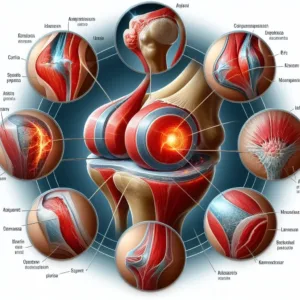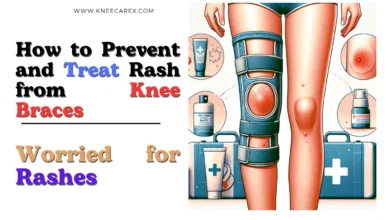How to Regenerate Meniscus Naturally | Heal Torn Meniscus Naturally

The meniscus is a shock-absorbing cartilage in the knee joint, which helps distribute the forces exerted on the joint and acts as a cushion between the thighbone and shinbone. Tears in the meniscus are usually caused by sudden movements, sports injuries, aging, or overuse of the joint.
Contents
- 1 How to Regenerate Meniscus Naturally
- 2 Anatomy of the Meniscus: Structure and Function
- 3 Causes and Symptoms of a Torn Meniscus
- 4 Diet and Nutrition: Foods That Support Recovery
- 5 Exercises and Physical Therapy for Meniscus Regeneration
- 6 Alternative Remedies: Supplements, Herbs, and Acupuncture
- 7 FAQ’s
- 7.1 Can you regenerate the meniscus?
- 7.2 Can the meniscus rebuild itself?
- 7.3 How long does it take for a torn meniscus to heal without surgery?
- 7.4 Can a torn meniscus get better on its own?
- 7.5 How can I regenerate my meniscus naturally?
- 7.6 Can knee meniscus grow back?
- 7.7 What is the fastest way to recover from a meniscus tear?
- 7.8 Can a torn meniscus repair itself?
- 7.9 What foods help heal a torn meniscus?
- 7.10 What nutrients are good for the meniscus?
- 7.11 What promotes meniscus healing?
- 7.12 What rebuilds the meniscus?
- 7.13 Is it possible to regrow the meniscus?
- 7.14 How long does it take for the meniscus to regenerate?
- 7.15 How to regenerate the meniscus naturally?
- 7.16 How to heal a strained meniscus naturally?
- 7.17 Can you heal your meniscus without surgery?
- 7.18 Does the meniscus grow back?
- 7.19 Is walking good for a meniscus tear?
- 7.20 Meniscus tears: Can you play sports with a torn meniscus?
- 7.21 Patients frequently ask: Can you rehab a torn meniscus without surgery?
- 7.22 What Aggravates a Torn Meniscus?
- 7.23 What Are Some Ways To Heal Meniscus Tear Naturally?
- 7.24 What Are the Symptoms of a Torn Meniscus?
- 7.25 What Happens if You Don’t Repair a Torn Meniscus?
- 7.26 Is there a way to heal a torn meniscus naturally?
- 7.27 Can you make a meniscus tear heal faster?
- 7.28 Can a meniscus tear heal on its own?
- 7.29 Can exercise repair a torn meniscus?
- 7.30 Do I have a meniscus tear?
- 7.31 How can you tear your meniscus?
- 7.32 How can the meniscus be torn?
- 7.33 How long does it take for a torn meniscus to heal without surgery?
- 7.34 How long does a torn meniscus take to heal?
- 7.35 How long does it take for a meniscus tear to heal naturally?
- 7.36 How to know if you have a torn meniscus?
- 7.37 Can you rehab a torn meniscus without surgery?
- 7.38 What are some ways to heal meniscus tears naturally?
- 7.39 What are the symptoms of a torn meniscus?
- 7.40 What happens if you don’t repair a torn meniscus?
- 7.41 Is there a way to heal a torn meniscus naturally?
- 7.42 Can you make a meniscus tear heal faster?
- 7.43 Can a meniscus tear heal on its own?
- 7.44 Can exercise repair a torn meniscus?
- 7.45 Do I have a meniscus tear?
- 7.46 How can you tear your meniscus?
- 7.47 How long does it take for a torn meniscus to heal without surgery?
- 7.48 How long does a torn meniscus take to heal?
- 7.49 How long does it take for a torn meniscus to heal naturally?
- 7.50 How to know if you have a torn meniscus?
- 7.51 What are the symptoms of a torn meniscus?
- 7.52 What happens if you don’t repair a torn meniscus?
- 7.53 However, what is the evidence that having a meniscal surgery would help, and what are the types of meniscal surgeries?
- 7.54 Is there a way to heal a torn meniscus naturally?
- 7.55 Is walking good for a meniscus tear?
- 7.56 Meniscus tears: Can you play sports with a torn meniscus?
- 7.57 Patients frequently ask: Can you rehab a torn meniscus without surgery?
- 7.58 What Aggravates a Torn Meniscus?
- 7.59 What Are Some Ways To Heal Meniscus Tear Naturally?
- 7.60 What Are the Symptoms of a Torn Meniscus?
- 7.61 What Happens if You Don’t Repair a Torn Meniscus?
- 8 Conclusion: How to Regenerate Meniscus Naturally
How to Regenerate Meniscus Naturally

The initial phase of a meniscus injury can be reduced in size and inflammation by using ice and heat treatment. Collagen, calcium, vitamin D, and vitamin C are among the nutrients that are essential for joint health and tissue regeneration. Enough time must pass for the body to recover itself properly. It is advised to consult a healthcare provider for a clear diagnosis and treatment plan. In order to help a meniscus regenerate spontaneously, pay attention to these steps:
Keep Your Weight in Check: Carrying too much weight strains your knees, which can hasten the meniscus’ deterioration. Reducing stress and accelerating recovery can be achieved by maintaining a healthy weight.
Keep Yourself Active with Low-Impact Exercises: Take part in low-impact exercises that improve strength and general health, such as walking, cycling, or swimming, which are easy on the knees. Steer clear of high-impact exercises that might aggravate meniscus issues, such as running or leaping.
Strengthen the Knee Muscles: Increasing the strength of the muscles around your knees will help to stabilize and support the joint, which lowers the chance of future meniscus damage. Pay special attention to workouts that work your calves, hamstrings, and quads.
Increase Flexibility: To increase the flexibility of the tendons and muscles that surround the knee joint, include stretching activities in your daily routine. This can lessen strain on the meniscus by enhancing range of motion and reducing stiffness.
Maintain Good Posture and Body Mechanics: Throughout the day, be mindful of your posture and body mechanics, particularly while engaging in bending or lifting tasks. An injury can be prevented and knee strain can be lessened with proper alignment.
Put on Supportive Footwear: To lessen the stress on your knees during daily activities, put on supportive footwear that has adequate cushioning and shock absorption.
Check on Amazon: Supportive footwear
Use Ice and Heat Therapy: During the acute phase of a meniscus injury, apply ice packs to minimize swelling and inflammation. Use heat treatment to encourage blood flow and relaxation in the afflicted area once the inflammation has decreased.
Think About Nutritional Support: A number of nutrients, including collagen, calcium, vitamin D, and C, are important for aiding tissue regeneration and preserving joint health. Make sure your diet is balanced and full of these nutrients, or if necessary, think about taking supplements.
Check out Supplements: Vitamin D and C
Rest and Heal: Pay attention to your body’s needs and allow it enough time to heal from injuries or activities. To help the body repair, emphasize rest when it’s needed and refrain from overdoing it.
Speak with a Healthcare expert: For a precise diagnosis and individualized treatment plan, speak with a healthcare expert if you’re dealing with chronic pain or issues with knee function. In extreme situations, they could suggest surgery. Other therapies include physical therapy and corticosteroid injections.
Anatomy of the Meniscus: Structure and Function
A C-shaped section of cartilage in the knee joint, the meniscus, is essential for preserving stability and transferring weight evenly throughout the joint. It is made of fibrocartilage and functions as a cushion between the tibia (shin bone) and femur (thigh bone), absorbing stress and reducing friction during movement. Its distinctive form offers structural support and permits seamless knee articulation.
The medial meniscus, located on the inside side of the knee, and the lateral meniscus, located on the outside, make up the meniscus’s structural components. Ligaments entwine these structures to keep them in place and guarantee appropriate function. For the knee to function well overall, these components must be preserved since any tearing or injury may result in discomfort, edema, and restricted range of motion. Knowing the meniscus’s complex architecture helps to clarify its vital function in keeping knees healthy and emphasizes the need to use natural healing techniques to successfully restore damaged tissue.
Causes and Symptoms of a Torn Meniscus

The symptoms of a torn meniscus might mirror those of other knee conditions, such as arthritis or ligament damage, which makes diagnosis difficult. While some individuals feel as if their knee is giving out while engaging in activities, others may experience locking or catching feelings in their knee joint. A medical professional’s advice is essential if you want an accurate diagnosis and a treatment plan that is customized for your unique circumstances.
Can You Run with a Torn Meniscus? Expert Insights and Recommendations
By being aware of the signs and causes of a torn meniscus, you may take proactive measures to repair and stop additional injury to your knees. For long-term well-being, you may investigate natural methods to rebuild your meniscus tissue and enhance overall knee health by recognizing these symptoms early and getting the care you need. Recall that promoting your body’s natural healing processes depends on paying attention to the signals your body sends you and taking quick action to address any issues.
Diet and Nutrition: Foods That Support Recovery
Diet and nutrition play a critical role in the healing process after meniscus tears. Foods high in anti-inflammatory qualities, such as leafy greens, nuts, seeds, and fatty fish, may help reduce knee joint inflammation and accelerate recovery. Collagen-rich foods like citrus fruits, bone broth, and chicken skin may also help to regenerate the meniscus tissue naturally.
Additionally, emphasizing a diet high in antioxidant-rich fruits and vegetables helps speed up the healing process by reducing oxidative stress brought on by damage. Drinking plenty of water or herbal teas helps maintain joint health generally and makes sure that nutrients are properly supplied to injured tissues for the best possible recovery. You may help your body’s natural capacity to regenerate the meniscus without intrusive procedures by choosing well-informed dietary choices that encourage a balanced inflammatory response and provide vital nutrients for tissue regeneration.
Exercises and Physical Therapy for Meniscus Regeneration

Strength training and low-impact activities should be used in a balanced way when it comes to meniscus regeneration exercises. Concentrate on exercises that work the hamstrings, quadriceps, and calves; include stretches to increase range of motion. Personalized exercise regimens designed to meet particular requirements and objectives might significantly improve healing during physical therapy sessions with a qualified practitioner. Recall that for meniscus regeneration via exercise and physical therapy to provide long-lasting improvements, good form, and progressive progression are critical.
Alternative Remedies: Supplements, Herbs, and Acupuncture
Alternative treatments such as acupuncture, herbs, and vitamins might be promising in repairing the meniscus organically. Some supplements, such as glucosamine and chondroitin, may promote joint health and help mend damaged cartilage. These organic compounds support tissue regeneration, lessen inflammation, and enhance joint function in general.
Due to their ability to reduce inflammation and ease the pain associated with a torn meniscus, herbal medicines such as turmeric and ginger are increasingly becoming more and more popular. By including these herbs in your diet or taking them as supplements, you can promote healing and alleviate symptoms. Additionally, acupuncture has been shown to be a successful therapy for a number of musculoskeletal disorders, including injuries to the knee. Acupuncture may activate the body’s natural healing processes for meniscus repair by improving circulation in the afflicted region and targeting particular acupoints associated with pain management.
Homemade Knee Brace: How to Make a Knee Brace at home 2024
FAQ’s
Can you regenerate the meniscus?
The meniscus has limited ability to regenerate on its own due to its poor blood supply. However, certain treatments, such as regenerative medicine therapies, may help stimulate some degree of regeneration.
Can the meniscus rebuild itself?
The meniscus has a limited ability to heal itself, particularly in the outer third, where there is a blood supply. However, tears in the inner two-thirds, which lack a blood supply, are less likely to heal on their own.
How long does it take for a torn meniscus to heal without surgery?
The time it takes for a torn meniscus to heal without surgery varies greatly depending on the severity of the tear and individual factors. In some cases, it may take several weeks to months for symptoms to improve.
Can a torn meniscus get better on its own?
In some cases, a torn meniscus may get better on its own, especially if it is small and located in the outer third of the meniscus where there is a blood supply.
How can I regenerate my meniscus naturally?
There is no definitive way to regenerate the meniscus naturally. Still, certain lifestyle changes, such as maintaining a healthy weight and avoiding activities that put stress on the knee, may help prevent further damage.
Can knee meniscus grow back?
The meniscus has a limited ability to heal and regenerate, particularly in the outer third, where there is a blood supply. However, tears in the inner two-thirds, which lack a blood supply, are less likely to heal on their own.
What is the fastest way to recover from a meniscus tear?
The fastest way to recover from a meniscus tear depends on the severity of the tear and individual factors. In some cases, rest, ice, compression, and elevation (RICE) may help reduce pain and swelling, while physical therapy may help improve strength and range of motion.
Can a torn meniscus repair itself?
In some cases, a torn meniscus may repair itself, particularly if it is small and located in the outer third of the meniscus where there is a blood supply.
What foods help heal a torn meniscus?
A diet rich in anti-inflammatory foods, such as fruits, vegetables, whole grains, and fatty fish, may help promote healing and reduce inflammation in the knee.
What nutrients are good for the meniscus?
Certain nutrients, such as vitamin C, vitamin D, and omega-3 fatty acids, may help promote healing and reduce inflammation in the meniscus.
What promotes meniscus healing?
Rest, ice, compression, and elevation (RICE) may help promote meniscus healing, as may physical therapy to improve strength and range of motion.
What rebuilds the meniscus?
Regenerative medicine therapies, such as platelet-rich plasma (PRP) injections, may stimulate some degree of regeneration in the meniscus.
Is it possible to regrow the meniscus?
While the meniscus has a limited ability to heal and regenerate, regrowing a meniscus to its original state is not currently possible.
How long does it take for the meniscus to regenerate?
The time it takes for the meniscus to regenerate varies greatly depending on the severity of the tear and individual factors. In some cases, it may take several weeks to months for the meniscus to heal.
How to regenerate the meniscus naturally?
There is no definitive way to regenerate the meniscus naturally. Still, certain lifestyle changes, such as maintaining a healthy weight and avoiding activities that put stress on the knee, may help prevent further damage.
How to heal a strained meniscus naturally?
Rest, ice, compression, and elevation (RICE) may help reduce pain and swelling associated with a strained meniscus. Physical therapy may also help improve strength and range of motion.
Can you heal your meniscus without surgery?
In some cases, a meniscus tear may heal without surgery, particularly if it is small and located in the outer third of the meniscus where there is a blood supply.
Does the meniscus grow back?
The meniscus has a limited ability to heal and regenerate, particularly in the outer third, where there is a blood supply. However, tears in the inner two-thirds, which lack a blood supply, are less likely to heal on their own.
Is walking good for a meniscus tear?
Walking can be beneficial for a meniscus tear, as it can help maintain strength and flexibility in the knee. However, it is important to avoid activities that put excessive stress on the knee, such as running or jumping.
Meniscus tears: Can you play sports with a torn meniscus?
Playing sports with a torn meniscus is not recommended, as it can increase the risk of further damage to the meniscus and other structures in the knee.
Patients frequently ask: Can you rehab a torn meniscus without surgery?
Rehabilitation without surgery may be possible for some meniscus tears, particularly if they are small and located in the outer third of the meniscus where there is a blood supply.
What Aggravates a Torn Meniscus?
Activities that put stress on the knee, such as running, jumping, or twisting, can aggravate a torn meniscus and increase pain and swelling.
What Are Some Ways To Heal Meniscus Tear Naturally?
Rest, ice, compression, and elevation (RICE) may help reduce pain and swelling associated with a meniscus tear. Physical therapy may also help improve strength and range of motion.
What Are the Symptoms of a Torn Meniscus?
Symptoms of a torn meniscus may include pain, swelling, stiffness, and a locking or catching sensation in the knee.
What Happens if You Don’t Repair a Torn Meniscus?
If a torn meniscus is not repaired, it can lead to chronic pain, swelling, and stiffness in the knee, as well as an increased risk of developing arthritis in the future.
Is there a way to heal a torn meniscus naturally?
Healing a torn meniscus naturally is possible in some cases, particularly for small tears in the outer third of the meniscus where there is a blood supply. However, it is important to consult with a healthcare professional to determine the best course of treatment based on the specific characteristics of the tear and the individual’s overall health.
Can you make a meniscus tear heal faster?
While there is no guaranteed way to speed up the healing process of a meniscus tear, certain measures may help promote healing and reduce recovery time. These include:
- Resting the knee and avoiding activities that put stress on the joint.
- Applying ice to reduce swelling and pain.
- Using compression bandages to support the knee.
- Elevating the leg to reduce swelling.
- Following a rehabilitation program prescribed by a healthcare professional to strengthen the knee and improve the range of motion.
Can a meniscus tear heal on its own?
In some cases, a meniscus tear may heal on its own, particularly if it is small and located in the outer third of the meniscus where there is a blood supply. However, larger tears or tears in the inner two-thirds of the meniscus, which lack a blood supply, are less likely to heal without surgical intervention.
Can exercise repair a torn meniscus?
Exercise can improve strength, flexibility, and stability in the knee, which may help reduce symptoms associated with a torn meniscus. However, it is important to consult with a healthcare professional before starting any exercise program to ensure that it is safe and appropriate for your specific condition.
Do I have a meniscus tear?
If you are experiencing symptoms such as pain, swelling, stiffness, or a locking or catching sensation in your knee, you may have a meniscus tear. It is important to consult with a healthcare professional for an accurate diagnosis and appropriate treatment plan.
How can you tear your meniscus?
A meniscus tear can occur as a result of a sudden twisting or bending motion, particularly when the foot is planted on the ground. It can also occur due to repetitive stress or degenerative changes in the knee joint.
How can the meniscus be torn?
The meniscus can be torn due to a variety of reasons, including traumatic injuries, such as sports-related injuries or accidents, as well as degenerative changes that occur with age or overuse.
How long does it take for a torn meniscus to heal without surgery?
The time it takes for a torn meniscus to heal without surgery varies depending on the severity of the tear and the individual’s overall health. In some cases, it may take several weeks to months for symptoms to improve.
How long does a torn meniscus take to heal?
The time it takes for a torn meniscus to heal depends on various factors, including the type and location of the tear, as well as the individual’s age and overall health. In some cases, it may take several weeks to months for symptoms to improve.
How long does it take for a meniscus tear to heal naturally?
The time it takes for a meniscus tear to heal naturally varies depending on the severity of the tear and the individual’s overall health. In some cases, it may take several weeks to months for symptoms to improve.
How to know if you have a torn meniscus?
If you are experiencing symptoms such as pain, swelling, stiffness, or a locking or catching sensation in your knee, you may have a torn meniscus. It is important to consult with a healthcare professional for an accurate diagnosis and appropriate treatment plan.
Can you rehab a torn meniscus without surgery?
Rehabilitation without surgery may be possible for some meniscus tears, particularly if they are small and located in the outer third of the meniscus where there is a blood supply. Physical therapy can help improve strength, flexibility, and stability in the knee.
What are some ways to heal meniscus tears naturally?
Rest, ice, compression, and elevation (RICE) can help reduce the pain and swelling associated with a meniscus tear. Physical therapy can also help improve knee strength and range of motion.
What are the symptoms of a torn meniscus?
Symptoms of a torn meniscus may include pain, swelling, stiffness, and a locking or catching sensation in the knee. These symptoms may worsen with certain activities, such as squatting or twisting.
What happens if you don’t repair a torn meniscus?
If a torn meniscus is not repaired, it can lead to chronic pain, swelling, and stiffness in the knee, as well as an increased risk of developing arthritis in the future. It is important to consult with a healthcare professional for an accurate diagnosis and appropriate treatment plan.
Is there a way to heal a torn meniscus naturally?
While the meniscus has limited natural healing abilities, there are steps you can take to potentially promote healing and reduce symptoms:
- Rest and avoid activities that worsen symptoms.
- Apply ice to reduce pain and swelling.
- Use compression bandages to support the knee.
- Elevate the leg to reduce swelling.
- Physical therapy to strengthen the knee muscles and improve flexibility.
- Maintain a healthy weight to reduce stress on the knee.
Can you make a meniscus tear heal faster?
While there’s no guaranteed way to speed up the healing process for a meniscus tear, following your doctor’s recommendations for rest, ice, compression, and elevation (RICE) and adhering to a physical therapy regimen can help optimize the process.
Can a meniscus tear heal on its own?
Small tears in the outer third of the meniscus, where there is a blood supply, have a better chance of healing on their own with conservative treatments. However, larger tears or tears in the inner two-thirds, which lack a blood supply, are less likely to heal without surgical intervention.
Can exercise repair a torn meniscus?
Exercise can strengthen the muscles around the knee and improve flexibility, which can help support the knee joint and reduce the risk of further injury. However, exercise alone is unlikely to repair a torn meniscus and may not be appropriate during the acute phase of injury.
Do I have a meniscus tear?
If you experience symptoms such as pain, swelling, stiffness, or a locking/catching sensation in your knee, you may have a meniscus tear. It’s important to see a healthcare provider for a proper diagnosis and treatment plan.
How can you tear your meniscus?
A meniscus tear can occur due to a sudden twisting or rotating movement of the knee, often during sports or other physical activities. It can also result from degenerative changes in the knee over time.
How long does it take for a torn meniscus to heal without surgery?
The time it takes for a torn meniscus to heal without surgery varies depending on the severity of the tear and individual factors. In some cases, it may take several weeks to months for symptoms to improve.
How long does a torn meniscus take to heal?
The time it takes for a torn meniscus to heal depends on various factors, including the type and location of the tear, the individual’s overall health, and the treatment approach. In general, it can take several weeks to months for a meniscus tear to heal completely.
How long does it take for a torn meniscus to heal naturally?
The healing time for a torn meniscus can vary greatly depending on the severity of the tear and individual factors. In some cases, it may take several weeks to months for symptoms to improve with conservative treatments.
How to know if you have a torn meniscus?
If you experience symptoms such as pain, swelling, stiffness, or a locking/catching sensation in your knee, you may have a torn meniscus. It’s important to see a healthcare provider for a proper diagnosis and treatment plan.
What are the symptoms of a torn meniscus?
Symptoms of a torn meniscus may include pain, swelling, stiffness, and a locking or catching sensation in the knee. The severity of symptoms can vary depending on the type and location of the tear.
What happens if you don’t repair a torn meniscus?
If a torn meniscus is not repaired, it can lead to chronic pain, swelling, and stiffness in the knee, as well as an increased risk of developing arthritis in the future. It’s important to follow your healthcare provider’s recommendations for treatment to prevent these complications.
However, what is the evidence that having a meniscal surgery would help, and what are the types of meniscal surgeries?
The decision to undergo meniscal surgery should be based on individual factors, such as the location and severity of the tear, as well as the patient’s age, activity level, and overall health. Several studies have shown that arthroscopic meniscal surgery can be effective in relieving symptoms and improving function in patients with meniscal tears, particularly in those with mechanical symptoms such as locking or catching.
There are several types of meniscal surgeries, including:
- Meniscectomy: This involves removing part or all of the damaged meniscus. It is typically done for tears that cannot be repaired.
- Meniscus repair: This involves stitching the torn edges of the meniscus together. It is typically done for tears in the outer third of the meniscus where there is a blood supply.
- Meniscus transplant: This involves replacing a damaged meniscus with a donor meniscus. It is typically done in younger patients with extensive meniscus damage.
Is there a way to heal a torn meniscus naturally?
While some meniscus tears may heal on their own, particularly those in the outer third of the meniscus where there is a blood supply, there is no definitive way to heal a torn meniscus naturally. However, certain lifestyle changes, such as maintaining a healthy weight and avoiding activities that put stress on the knee, may help prevent further damage.
Is walking good for a meniscus tear?
Walking can be beneficial for a meniscus tear, as it can help maintain strength and flexibility in the knee. However, it is important to avoid activities that put excessive stress on the knee, such as running or jumping.
Meniscus tears: Can you play sports with a torn meniscus?
Playing sports with a torn meniscus is not recommended, as it can increase the risk of further damage to the meniscus and other structures in the knee.
Patients frequently ask: Can you rehab a torn meniscus without surgery?
Rehabilitation without surgery may be possible for some meniscus tears, particularly if they are small and located in the outer third of the meniscus where there is a blood supply.
What Aggravates a Torn Meniscus?
Activities that put stress on the knee, such as running, jumping, or twisting, can aggravate a torn meniscus and increase pain and swelling.
What Are Some Ways To Heal Meniscus Tear Naturally?
Rest, ice, compression, and elevation (RICE) may help reduce pain and swelling associated with a meniscus tear. Physical therapy may also help improve strength and range of motion.
What Are the Symptoms of a Torn Meniscus?
Symptoms of a torn meniscus may include pain, swelling, stiffness, and a locking or catching sensation in the knee.
What Happens if You Don’t Repair a Torn Meniscus?
If a torn meniscus is not repaired, it can lead to chronic pain, swelling, and stiffness in the knee, as well as an increased risk of developing arthritis in the future.
Conclusion: How to Regenerate Meniscus Naturally
In conclusion, the natural methods discussed in this article offer a promising approach to regenerating and healing a torn meniscus without the need for invasive procedures. By incorporating these techniques into your daily routine, you can support the body’s natural healing process and promote tissue regeneration. Remember to be patient and consistent in your efforts, as results may take time to manifest. Embracing a holistic approach that includes proper nutrition, exercise, and lifestyle changes can significantly contribute to the recovery and health of your meniscus. Start implementing these strategies today, and watch as your body responds with renewed strength and vitality!




